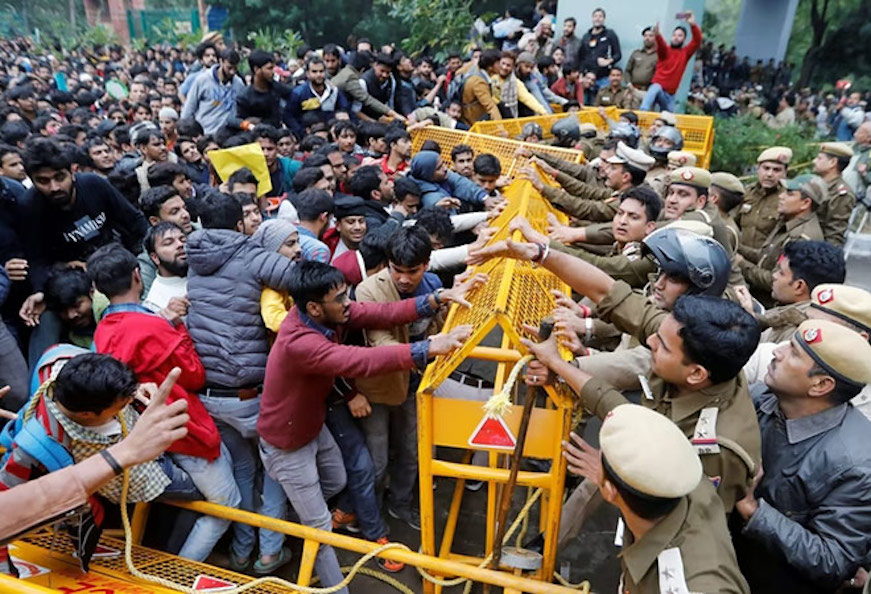-
CENTRES
Progammes & Centres
Location
The new characteristics acquired by the recent protests and demonstrations in democratic countries raise concerns

Anti-government protests and demonstrations are increasingly becoming a feature of democracies around the world, probably unparalleled earlier in “frequency, scope, and size”, prompting the ongoing decade and the decade gone by to be labelled as the ‘Age of Mass Protests”. Some of the most prominent mass demonstrations that received global traction were Anna Hazare’s agitation that riveted attention on public corruption and catalysed the birth of a political party, the ‘Matter protests in the United States and around the world against police excesses, the anti-COVID-19 lockdown, vaccine rollout and wage protests in the United Kingdom, demonstrations against vaccine mandates in Canada, riots in France over police shooting, protests in Iran against the compulsion of a dress code for women, political protests in Hong Kong and Pakistan, protests in Bangladesh demanding fresh elections, protracted demonstrations in Israel against judicial reforms and agitations in a cluster of African countries (South Africa, Kenya, Tunisia, Senegal and Nigeria) over the escalating cost of living, corruption, unemployment and economic crisis, to name a few.
The complexity of issues, competing interests and the freedoms afforded to citizens in democracies allow groups of people to lawfully vent their dissatisfaction openly and to place their counter-demands before decision-makers.
While countries witnessing mass agitations also include non-democratic countries, such as anti-lockdown protests in multiple cities in China, this article limits itself to a discussion of protests in democracies. The complexity of issues, competing interests and the freedoms afforded to citizens in democracies allow groups of people to lawfully vent their dissatisfaction openly and to place their counter-demands before decision-makers. It is understandable that democracies, especially those as huge and diverse as India, would have a large share of such events. However, the mere multiplicity of protests should be no cause for unwarranted concern as it is like democracies to allow dissent and promote free speech. This is especially so in India since Article 19 of the Indian Constitution permits all Indian citizens the freedom of speech and expression and the right to assemble peacefully without arms.
The rising concern about protests arises from some new characteristics these events have acquired. Firstly, large cities have become the preponderant centres of demonstrations. In an age when it is easy to equip a local issue with global viewership, the organisers of protests cannot let go of the opportunity of visibility. It is this conspicuousness that gets the attention of a large number of people, nationally and internationally. Even if a fraction of the people view the visible content on news channels or videos circulated on social media and weigh in with their comments, these prove enough to rattle most administrations. The cities enable the protesters since the cities provide all the ingredients that make up for visibility. Most media channels and the press are located in cities; social media is most active here, and the cities have large populations who directly experience the event of protests. The concern is that many protests that have political motivations seek to convert such agitations into weapons to slay the ruling dispensation or compel acceptance of their demands.
Here, large cities become excellent tools as they provide protesters with the ability to inconvenience millions of citizens by sitting on roads or blocking roads or other transport infrastructure such as railways, thereby choking movement and the transport of goods.
In this process of weaponisation, citizens are used as shooting targets by holding them to ransom. Here, large cities become excellent tools as they provide protesters with the ability to inconvenience millions of citizens by sitting on roads or blocking roads or other transport infrastructure such as railways, thereby choking movement and the transport of goods. This is even though the laws of the land place ‘reasonable restrictions’ on mass protests. They cannot compromise the sovereignty and integrity of the nation; the state’s security cannot be adversely impacted, and public order must not be disturbed. These stipulations are spelt out in the Indian Penal Code, the Police Act and the Criminal Procedure Code. Hence agitations that impede the flow of traffic or create a nuisance in public spaces are not within the bounds of the law.
Generally, cities have designated spaces for protests, or the city police should have approved the spot chosen for mass protests. In any event, prior permission from the police is mandatory. Mass agitations that disturb public peace and order, therefore, cross the boundaries of the law. However, the law is often disregarded since the objective of the agitations in question is to do precisely what the law disallows.
The role of technology as an enabler in this context cannot be underestimated. Technology has made it possible to manipulate the crowd, circulate fake material, arouse emotions and exploit the surcharged crowd’s anger. Mobile phones and social media have emerged as powerful communication devices. Ring leaders and agent provocateurs of crowds generally act from behind the scenes using sophisticated tools and methods, not very easy to discern and trace quickly. This is aided by the highly fractured nature of politics in the country, and the willingness to use extreme methods and draw international support and money, all aimed at creating mayhem. Driving ruling parties and governments into a corner through rowdy and animated groups of crowds, intermixed with violent criminals that are ready to cause untold harm, has now emerged as a widely witnessed phenomenon.
Ring leaders and agent provocateurs of crowds generally act from behind the scenes using sophisticated tools and methods, not very easy to discern and trace quickly.
As the protests turn into a civic nuisance, two outcomes could follow. The administration may get pressured into negotiating with the protesters, thereby conceding part or whole of their demand. Alternatively, the administration could ignore the protesters, leading to violence and large-scale acts of damage to property and arson. The police may then be obligated to use force and, in the process, kill or injure members of the protest or bystanders, which can then be highlighted and exploited to show the administration as cruel and barbaric, depending upon the outcome of the use of force. This is expected to generate public abhorrence for the government and the ruling political party and cost them votes/elections locally or nationally. It is evident that handling modern protests requires high levels of preparedness and training of the police force and the availability of police personnel in high numbers.
Two recent mass protests in India bear out the analysis presented above. One was the protest against the Citizenship Amendment Act (CAA) in December 2019. The other was the farmers’ protest in 2020-21. The former was organised after the passage of the Citizenship Amendment Bill in Parliament. The protesters demanded that the CAA should not be implemented and the preparation of the proposed National Register of Citizens (NRC) should be dropped. The farmers’ agitation was essentially against three farm laws that, in the eyes of the agitators, sought the ‘corporatisation’ of agriculture to the detriment of the farmers. These laws were finally repealed. Both these incidents led to violence and prolonged misery for citizens caught amidst the protests. Besides, there was widespread destruction of property as well as deaths.
The protesters demanded that the CAA should not be implemented and the preparation of the proposed National Register of Citizens (NRC) should be dropped.
What was worrying was that the administration was found wavering and unable to decide for a long time whether to intervene and break up the congregation of protesters (who had clearly crossed the boundaries of law) or to play safe and allow the situation to play itself out. The fact that the agitation was allowed to go on for a long time on significant transport routes at the cost of millions of commuters gave the impression that the administration had decided to wait and watch. The Prakash Singh Committee Report in the context of the Jat Agitations in Haryana in 2016 had observed that there was administrative paralysis at the state level and hesitation to use force at the district level indicating the abdication of the constitutional responsibility of the administration of maintaining law and order. A similar conclusion could be drawn in the two cited cases. There was reluctance to take a chance on repercussions, including political, that could follow post the use of force.
In light of this background, it is evident that mass protests are likely to be viewed from several angles, along with the lens of public order, before a final decision is made. This reluctance to act on the part of the administration is likely to encourage more agitations in the future.
The views expressed above belong to the author(s). ORF research and analyses now available on Telegram! Click here to access our curated content — blogs, longforms and interviews.

Dr. Ramanath Jha is Distinguished Fellow at Observer Research Foundation, Mumbai. He works on urbanisation — urban sustainability, urban governance and urban planning. Dr. Jha belongs ...
Read More +